Trams in Kolkata
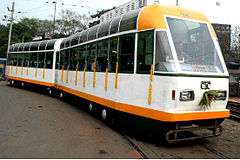 | |||
| Overview | |||
|---|---|---|---|
| Locale | Kolkata | ||
| Transit type | Tram | ||
| Number of lines | 25[1] | ||
| Daily ridership | 255,000 daily | ||
| Operation | |||
| Began operation | 1873[2] | ||
| Operator(s) | Calcutta Tramways Company | ||
| Reporting marks | CTC | ||
| Number of vehicles | 257 trams (80 in operation)[3] | ||
| Technical | |||
| System length | 8 km [4] | ||
| Track gauge | Standard gauge 1,435 mm (4 ft 8 1⁄2 in)[2] | ||
| Electrification | 550 V DC Overhead line | ||
| |||
The tram system in the city of Kolkata, West Bengal, India, operated by the Calcutta Tramways Company (CTC), is the only tram network operating in India.[5] The oldest operating electric tram system in Asia, it has been running since 1902.[6]
History
1873–1901: Horse-drawn trams
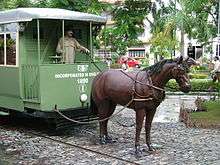
The first horse-drawn trams in India ran for 2.4 miles (3.9 km) between Sealdah and Armenian Ghat Street on 24 February 1873. The service was discontinued on 20 November of that year.[2] The Calcutta Tramway Company was formed and registered in London on 22 December 1880. Metre-gauge horse-drawn tram tracks were laid from Sealdah to Armenian Ghat via Bowbazar Street, Dalhousie Square and Strand Road. The route was inaugurated by the Viceroy, Lord Ripon, on 1 November 1880.[2] In 1882, steam locomotives were deployed experimentally to haul tram cars. By the end of the century, the company owned 166 tram cars, 1,000 horses, seven steam locomotives and 19 miles of track.[2]
1900–1951: Electric trams
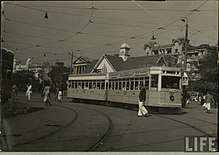
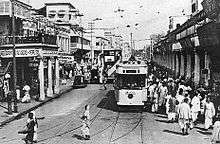
In 1900, the electrification of the tramway and conversion of its tracks to 4 ft 8 1⁄2 in (1,435 mm) (standard gauge) began.[2] The first electric tramcar in India ran from Esplanade to Kidderpore on 27 March 1902, with service from Esplanade to Kalighat introduced on 14 June of that year. The Kalighat line was extended to Tollygunge, the Esplanade line to Belgachia (via Bidhan Sarani, Shyambazar), and the Esplanade to Sealdah route (via Binay Badal Dinesh Bag, Rajib Gandhi Sarani and present-day Mahatma Gandhi Road) opened the following year. In 1904, the Esplanade to Bagbazar route through College Street opened. In June 1905, the Howrah Station to Bandhaghat route opened and the electrification project was completed.[2] In 1906, the Bowbazar Junction to Binay Badal Dinesh Bag and the Ahiritola Junction to Hatibagan Junction routes opened.
Two years later, lines to Shibpur via G.T. Road were laid and the Esplanade to Sealdah station (via Moula Ali Junction), Moula Ali Junction to Nonapukur, Wattganj Junction to Jatin Das Park Junction (via Alipur) and Mominpur Junction to Behala routes opened. The Sealdah Station to Rajabazar route opened in 1910. In 1915, the Mirzapur Junction to Bowbazar Junction and Sealdah Station to Lebutala Junction routes opened. Five years later, the Strand Road Junction to High Court route opened. In 1923, the S. C. Mallik Square Junction to Park Circus route (via Royd Street, Nonapukur) opened. The Kalighat to Ballygunge route opened in 1928. In 1930, the Park Circus line was extended to Garhiahat Junction. The Rajabazar line was extended to Galiff Street in 1941. In February 1943, the Calcutta and Howrah sections were connected by the new Howrah Bridge. With this extension, total track length reached 42.0 miles (67.59 km).[2]
1951–1990: Nationalisation
In 1951, the government of West Bengal entered an agreement with the Calcutta Tramways Company and the Calcutta Tramways Act of 1951 was enacted. The government assumed the tramways, reserving the right to purchase the system with two years' notice on 1 January 1972 or at any time thereafter.[2] In 1967, the Government of West Bengal passed the Calcutta Tramways Company (Taking Over of Management) Act and assumed management on 19 July. On 8 November 1976, the Calcutta Tramways (Acquisition of Undertaking) ordinance was promulgated under which the company (and its assets) was nationalised.[2] The Howrah sections were closed in October 1970; the 1971–1973 Nimtala route was closed in May 1973, and the Howrah Station terminus was realigned. Total track length was now reduced to 38 miles (61.2 km).[2]
In 1980, the routes on Bentinck Street and Ashutosh Mukhopadhyay Road closed for construction of the Kolkata metro and were not reopened. Two years later, the Sealdah Station terminus and the Sealdah–Lebutala route on Bipin Bihari Ganguli Street closed for the construction of an overpass; the site is now occupied by Sealdah Court and a bus terminal. On 17 April 1985, tracks were extended 3.7 km (2.30 mi) from Maniktala to Ultadanga via Maniktala Main road and C. I. T. Road.[2] On 31 December 1986, the route extension from Behala to Joka was completed.[2]
1990–present
Calcutta Tramways Company introduced bus service on 4 November 1992 with a fleet of 40 buses.[2] The Howrah Station terminus closed and the tram tracks were removed on Howrah Bridge the following year, since the cantilever bridge was not strong enough for trams. The routes which terminated there were moved to the Burrabazar (Howrah Bridge) terminus (formerly Burrabazar Junction).
The system had degraded by the 1990s, and Minister for Transport Shyamal Chakraborty planned to close the network. However, Melbourne tram conductor Roberto D'Andrea befriended fellow Calcutta conductors during a 1994 visit. When D'Andrea heard about the planned network closure, he suggested an art project to decorate the trams (as was done in his home city). The project increased public awareness of the network and its value, ultimately saving it.[7]
In 1995, the High Court terminus closed for the reconstruction of Strand Road. Rails and wires were removed from there and from Strand Road, Hare Street and Shahid Khudiram Basu Road, and it is now the site of the newest Kolkata High Court building. In 2004, the Garhiahat Depot–Garhiahat Junction link on Gariahat Road closed for construction of the Gariahat overpass. Two years later, the Mominpur–Behala route on Diamond Harbour Road closed for the construction of an overpass at Taratala. Although it was initially planned to route tracks on the overpass after its completion, the road was later converted to a national highway and the plan was dismissed. The Wattgunge Junction– Mominpur Diamond Harbour Road, Mominpur–Jatin Das Park Judges Court Road and the Jatin Das Park–Kalighat Shyama Prasad Mukherjee Road routes were closed for reconstruction in 2007, and the Galiff Street terminus was realigned the following year. Irregular service from Bagbazar to Galiff Street became regular service with Route 7/12. Rails and overhead lines were removed from part of the Bidhan Sarani route and restored by the end of 2008.
In 2009, tracks on R. G. Kar Road from the Shyambazar five-point crossing to the Belgachia depot closed for reconstruction. The Joka-Behala route and the Behala depot closed for construction of the Joka-BBD Bag metro project two years later, and the Ballygunge-Kalighat route closed for reconstruction. The Lalbazar-Mirjapur down line was closed, but the up line remained. The Behala–Joka route and the Behala terminus were closed in 2012. On 30 September 2014, a tram converted into a museum opened to the public.[8] The Park Circus depot closed for construction of the Park Circus Flyover in 2015, and the Nonapukur Depot reopened; the Garhiahat Depot remained. The following year, the Gariahat section reopened after 12 years and the depot next to Gariahat Mall opened.
Rolling stock
CTC owns 257 trams, of which 125 run daily.[3] Each single-deck articulated car can carry 200 passengers (60 seated).
The early horse-drawn cars and steel cars manufactured before 1952 were imported from England. Early trams were single-coach, similar to those in Delhi, Mumbai, Chennai and Kanpur. Triple-coach trams were tried without success. Later stock was the SLT type: double-coach with three doors, four wheels under each coach and no wheels between coaches. SLT trams had no front iron net, but had a front-coach trolley pole. The both-end type had a front iron net and a rear-coach trolley pole. These were gradually replaced by articulated trams on all routes. The SLC type was introduced much later on the Bandhaghat line, and continued until its closure in 1971; after that, SLC trams began running on the G/H and T/G lines on the Kolkata side.
Two trams were recently renovated with front and back glass, fluorescent lights, FM radio, digital display boards, angled seats and a fibreglass ceiling. The Nonapukur workshop began manufacturing 19 new trams from 2008 to 2010, of which four are nearing completion. The roof is clear polycarbonate sheeting with a wide window, and it has comfortable seating and better visibility from within. The workshop is also renovating steel-body (BSCL) cars. With plans for banquet-cafeteria[9] and air-conditioned trams to attract commuters and foreign tourists (increasing CTC revenue), a single-coach, air-conditioned banquet tram has been introduced for heritage tours of North Kolkata in the morning and South Kolkata in the evening.[10] Although the air-conditioned tram had poor ridership when it was introduced,[11] more air-conditioned trams are planned.[3]
Types of rolling stock are:
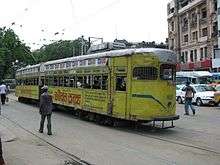
- Old SLC – The first double-coach tram with wheels between the coaches, manufactured at the Nonapukur workshop. Sometimes called an "elephant car" by the CTC, its cab and rear are narrow and slightly slanted forward (like the head of an elephant, without the trunk). It was introduced as a higher-speed tram with an improved engine, designed to run on express routes such as Galiff Street, Baliganj, Tollyganj, Behala and Khidirpur. Longer than an articulated tram, it was the first tram with a cab door.
- SLC – This variant has a pivot; less stylish than articulated trams, it is also manufactured at Nonapukur. Its front and back are straight. Also introduced as a higher-speed tram with an improved engine, it was designed to run on express routes but later had more general use.
- Articulated SLC – This is a slightly-less-stylish variation of the articulated tram, which is also manufactured at Nonapukur. Its front and back overhang, and narrow towards the ends. Also with an improved engine, it was used on local and express routes.
- Renovated SLC – After many years of SLC and articulated trams, rolling stock arrived from Burn Standard India which is stronger, heavier and faster than earlier designs and reversed the declining public perception of trams in the city. The improved stock began running throughout the city on all routes. Some were modified with front glass; two were modified to resemble Melbourne's B-class trams with fluorescent lights, back glass and double ends.
- New cars – Before the introduction of the single-coach tram in December 2012, this was the last new rolling stock. Built by Jessop India, it is a variation of the pivot type and was introduced around 1984. Some were modified with front glass; one was modified with fluorescent lights, FM radio, digital advertising and route boards.
- Single-coach – Introduced on 24 December 2012, they are reportedly faster and more manoeuvrable than double-coach trams; the carriage is longer than those in double-coach trams.[12] More single-coach trams are planned across the city (including air-conditioned coaches), possibly replacing double-coach trams and enabling some closed routes to reopen.[13]
Depots, terminals and workshops
There are seven tram depots (Belgachhia, Rajabazar, Park Circus, Gariahat, Tollygunge, Kalighat and Khidirpur), nine terminals (Shyambazar, Galiff Street, Bidhannagar, Ballygunge, Esplanade, B. B. D. Bagh, and Howrah Bridge), and a workshop in Nonapukur. The Rajabazar and Tollygunge depots are the largest in number tracks and area, respectively. The Khidirpur depot is the oldest, and Kalighat the smallest. The Esplanade terminus serves the largest number of routes.
A depot at Ghasbagan has been converted into a bus depot. The Shibpur, Bandhaghat, Bagbazar, Calcutta High Court, Nimtala, Behala, Joka, Sealdah, Howrah, M. P. Birla Planetarium and Racecourse terminals have been closed.
Routes
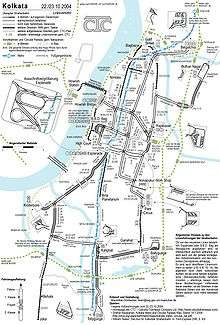
| Route no. | Description | Destination via | Total km |
|---|---|---|---|
| 1 | Belgachia – Esplanade | R.G.Kar Hospital, Shyambazar, Hatibagan, Bidhan Sarani, Vidyasagar college, College Street, Nirmal Chandra Street, Wellington, Lenin Sarani | 7.29[1] |
| 2 | Belgachia – BBD Bag | R.G.Kar Hospital, Kolkata Terminal Station(KOAA), Shyambazar, Hatibagan, Bidhan Sarani, Vidyasagar College, College Street, B.B.Ganguly Street, Lalbazar, Dalhousie | 6.81[1] |
| 4 | Belgachia – BBD Bag | R.G.Kar Hospital, Shyambazar, Hatibagan, Aurobindo Sarani, Sovabazar, Rabindra Sarani, Chitpur, Lalbazar, Dalhousie | 6.92[1] |
| 5 | Shyambazar – Esplanade | Hatibagan, Bidhan Sarani, Vidyasagar College, College Street,Calcutta University, Nirmal Chandra Street, Wellington, Lenin Sarani | 5.43[1] |
| 6 | Shyambazar – BBD Bag | Hatibagan, Bidhan Sarani,Vidyasagar College, College Street, Calcutta University, Nirmal Chandra Street, B.B. Ganguly Street, Bowbazar, Lalbazar | 5.13[1] |
| 8 | Bagbazar – BBD Bag | Rabindra Sarani – Lalbazar Street | 5.13[1] |
| 10 | Shyambazar – BBD Bag | Hatibagan, Aurobindo Sarani, Sovabazar, Rabindra Sarani, Chitpur, Lalbazar, Dalhousie | 5.13[1] |
| 11 | Belgachhia – Howrah Bridge | Hatibagan, Bidhan Sarani, College Street, Mahatma Gandhi Road | 6.00[1] |
| 12/1 | Belghachia – Esplanade | R.G. Kar Hospital, Shyambazar, APC Road, Khanna, Maniktala, Rajabazar, Sealdah, Moulali, Lenin Sarani | -[1] |
| 12/7 | Esplanade – Galiff Street | Rabindra Sarani – Lalbazar Street – Hemanta Basu Sarani | 6.92[1] |
| 14 | Rajabazar – BBD Bag | Sealdah, B.B. Ganguly Street, Bowbazar, Lalbazar | 4.81[1] |
| 15/12 | Rajabazar – Howrah Bridge | A.P.C.Road – Surya Sen St. – College Street Junction – Mahatma Gandhi Road | -[1] |
| 16 | Bidhan Nagar – BBD Bag | Ultadanga, Kankurgachi, Maniktala, Rajabazar, Sealdah, B.B. Ganguly Street, Bowbazar, Lalbazar | 8.14[1] |
| 17 | Bidhan Nagar – Esplanade | Ultadanga, Kankurgachi, Maniktala, Rajabazar, Sealdah, Moulali, Lenin Sarani | 7.95[1] |
| 18 | Bidhan Nagar – Howrah Bridge | Ultadanga, Kankurgachi, Maniktala, Rajabazar, Sealdah, College Street, Mahatma Gandhi Road | -[1] |
| 20 | Park Circus – Howrah Bridge | Mullick Bazar, Moulali, Sealdah, College Street, Mahatma Gandhi Road | 6.85[1] |
| 20/17 | Park Circus – Bidhan Nagar | Mullick Bazar, Moulali, Sealdah, Rajabazar, Maniktala, Kankurgachi, Ultadanga | 9.25[1] |
| 21 | Park Circus – Howrah Bridge | Mullickbazar, Rafi Ahamed Kidwai Road, Wellington, Lenin Sarani, Esplanade, Dalhousie, Lalbazar, Rabindra Sarani, Chitpur | 7.75[1] |
| 22 | Park Circus – Esplanade | Mullickbazar, Rafi Ahamed Kidwai Road, Wellington, Lenin Sarani | 5.65[1] |
| 24 | Ballygunge – Esplanade | Gariahat, Rashbehari, Hazra, Gopal Nagar, Mominpur, Kidderpore, Maidan | 4.99[1][14][15] |
| 24/29 | Tollygunge – Ballygunge | Deshapran Sashmal Road, Rashbehari Avenue | -[1] |
| 25 | Gariahat – Esplanade | Ballygunge Phari, Beckbagan, Park Circus, Mullickbazar, Rafi Ahamed Kidwai Road, Wellington, Lenin Sarani | 8.65[1] |
| 26 | Gariahat – Howrah Bridge | Ballygunge Phari, Park Circus, Mullick Bazar, Moulali, Sealdah, College Street, Mahatma Gandhi Road | 9.68[1] |
| 26/17 | Gariahat – Bidhan Nagar | Ballygunge Phari, Park Circus, Mullick Bazar, Moulali, Sealdah, Rajabazar, Maniktala, Kankurgachi, Ultadanga | -[1] |
| 29 | Tollygunge – Esplanade | Rashbehari, Hazra, Gopal Nagar, Mominpur, Kidderpore, Maidan | 4.99[1][14][15] |
| 29/36 | Tollygunge – Khidderpore | ||
| 36 | Khidderpore – Esplanade | Karl Marx Sarani – Kidderpore Road – Casuarina Avenue – Dufferin Road | 4.99[1] |
| 36/8 | Khidderpore – Esplanade & Bagbazar | BBD Bag – Chitpur | -[1] |
Accidents
On 3 December 2012, a seven-year-old was killed by a tram entering the Ultadanga depot. The boy was reportedly playing near the tracks when the tram approached, and it struck him before the brakes could be fully applied.[16]
A bus driver attempted to overtake a tram on 31 January 2013. The rear of the bus grazed the tram, amputating a bus passenger's arm. The man was rushed to hospital for his arm to be reattached.[17]
On 19 June 2014, a driverless tram struck 10 cars. No fatalities or injuries were reported.[18]
Future plans
Plans have been proposed to refurbish stock and wires, extend the system to Salt Lake, Rajarhat, Bantala[9] and the Hooghly riverfront,[19][20] and tunnel under the Hooghly River.[21] There have also been proposals to replace the current double-coach SLC trams with new single-coach trams. Although there has been occasional talk about gradually phasing out the tram system due to criticism that the trams occupy too much road space, slow down other road vehicles and carry too few passengers,[22] the system is also considered iconic and environmentally friendly.[23]
See also
References
- 1 2 3 4 5 6 7 8 9 10 11 12 13 14 15 16 17 18 19 20 21 22 23 24 25 26 27 28 Tram Routes
- 1 2 3 4 5 6 7 8 9 10 11 12 13 14 CTC website. Accessed 16 August 2013.
- 1 2 3 "Bankrupt CTC to introduce two more AC trams". The Times of India. 14 August 2013.
- ↑ http://calcuttatramways.com/about-ctc/
- ↑ "Reaching India". New Delhi: Times Internet Limited. Retrieved 27 February 2012.
- ↑ "Kolkata trams to get a GenX makeover". 13 July 2012.
- ↑ http://www.abc.net.au/news/2016-10-06/tramjatra-melbourne-and-kolkata-linked-by-tram-history/7904626
- ↑ "Calcutta Tramways Company inaugurates museum on wheels". 30 Sep 2014.
- 1 2 "Kolkata to get banquet and cafeteria trams". Daily News. 12 February 2013.
- ↑ "Enjoy Kolkata's heritage with an AC tram ride". The Economic Times. 18 April 2013.
- ↑ "Kolkata's modernised heritage trams fail to woo passengers". India Today. 24 June 2013.
- ↑ "City's new public ride arrives on Christmas Eve". hindustan times. 23 December 2012.
- ↑ "More single-coach trams to run on various streets in Kolkata soon". RailNews. 2013-03-26.
- 1 2 "Tram route gets new life on Panchami". 10 October 2013.
- 1 2 "Tram route back on track after 7 years". 18 October 2013.
- ↑ "Tram runs over 7-year-old". The Times of India. 3 December 2012.
- ↑ "'Passenger's arm ripped off as bus races tram in Kolkata". The Times of India. 31 January 2013.
- ↑ "'Ghost tram' rams into 10 cars in Kolkata". The Times of India. 20 June 2014.
- ↑ "New tram route on anvil to soak in riverfront views". The Times of India. 8 July 2013.
- ↑ "City tram network set for expansion". The Statesman. 12 September 2013.
- ↑ "Subhas dreams of tram below Hooghly". The Times of India. 21 May 2002.
- ↑ "State govt mulls phasing out trams from Kolkata streets". 27 Sep 2016.
- ↑ "Kolkata trams not to be scrapped". 22 May 2017.
Notes
- Niyogi, S. Shake, rattle & roll. The Sunday Story, Sunday Times of India, Kolkata, 25 June 2006. Available on Times of India e-paper (paid subscription required as of 2010).
- Pathak Pratap Shankar, The Sunday Story, Sunday Times of India, Kolkata
External links
| Wikimedia Commons has media related to Trams in Kolkata. |
- Official website of Calcutta Tramways Company
- Urbanrail.net page with schematic map of trams in Kolkata
- Geographical map of trams in Kolkata, both past and latest updates
- Some great photos of trams in Kolkata
- Department of Transport from the Government of West Bengal website
- A little more Information about trams in Kolkata
